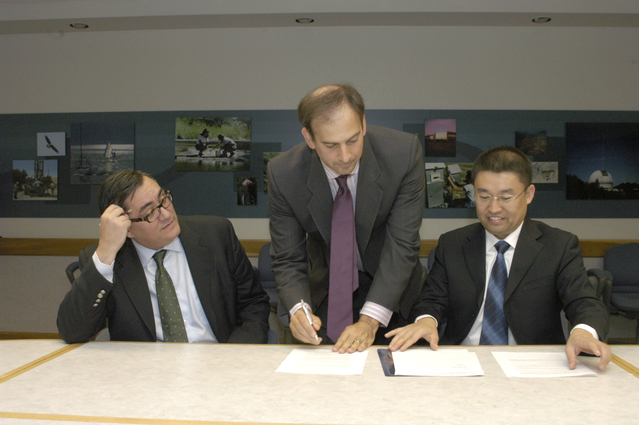LLNL assisting China in efforts to curb global warming
 (Download Image)
From left, Science and Technology Principal Associate Director Tomás Díaz de la Rubia, Julio Friedmann, head of LLNL's Carbon Management Program, and Xu Shisen, chief engineer for the Thermal Power Research Institute in China, sign a memorandum of understanding on October 9, 2009. Photo by Bob Hirschfeld
(Download Image)
From left, Science and Technology Principal Associate Director Tomás Díaz de la Rubia, Julio Friedmann, head of LLNL's Carbon Management Program, and Xu Shisen, chief engineer for the Thermal Power Research Institute in China, sign a memorandum of understanding on October 9, 2009. Photo by Bob Hirschfeld
The United States could look to China for inspiration to curb global warming.
According to a recent National Resources Defense Council (NRDC) report, China could become a world leader in the development and deployment of technology to capture carbon dioxide and store it underground.
The United States and China are the two largest emitters of CO 2 in the atmosphere. So it only makes sense that the two countries could partner to ensure that carbon emissions diminish not only by new technologies such as wind and solar, but through carbon capture and sequestration (CCS).
Livermore is playing a critical role in working with private and public Chinese companies on CCS at new and existing coal-powered plants and in projects using underground coal gasification (UCG), a process that converts coal in the ground to natural gas. Both coal-powered and UCG plants emit CO 2 to create electricity.
China is well-suited to adopt CCS technologies from an economic and geologic perspective. For starts, costs for carbon capture are likely to be lower than in Western countries due to lower fuel, material and labor costs. Additionally, China’s geology and the location of large CO 2 point sources near potential geologic sinks, such as saline formations, match well.
Given the world’s current heavy reliance on fossil fuels, nations must pursue a wide portfolio of carbon mitigation strategies. And CCS could be one of the most critical and quickest ways to do it in the short-term, said Julio Friedmann, leader of the Lab’s Carbon Management Program.
"We have to do this incredibly fast," he said. "We need to build them bigger and faster than we can possibly build them."
The most recent Intergovernmental Panel on Climate Change (IPCC) reported that in order to avoid its worst consequences, the world has to limit global warming by 2 degrees Celsius or less by reducing its carbon emissions at least 50 percent below 1990 levels by the year 2050.
"The goal of mitigation of CO 2 emissions is for the world - helping China is helping us," said S. Ming Sung of the Clean Air Task Force and one of the authors of the NRDC report."We can do it in China quicker, cheaper and easier. LLNL can help us on CCS and renewables, like wind."
Through the DOE Office of Fossil Energy, the Laboratory has received funding to partner with the Shenhua Group – China’s largest coal producer – to develop CCS at its direct coal liquefaction plant. The plant is scheduled to open in 2010/11 with an eventual goal of sequestering 2.9 megatons of CO 2 per year.
In addition, the Laboratory has been approached by the private company, XinAo Group, to advise on using UCG at a new power plant in Inner Mongolia.
In both of these projects, the Laboratory is a major technical contributor in sequestration and engineering technology.
"The Lab’s capabilities and expertise are well-suited to make a large contribution to U.S./China relations," Friedmann said.
In addition, the Laboratory has signed memorandums of understanding with the ENN Group, one of China's largest privately-held, diversified energy companies, and China’s Thermal Power Research Institute (TPRI).
The TPRI agreement paves the way for the Laboratory to be a major technical contributor in sequestration and engineering technology for GreenGen, a Chinese demonstration project that will sequester CO 2 from a coal-based power plant. GreenGen aims to research, develop and demonstrate a coal-based power generation system with hydrogen production through coal gasification, power generation from a combined-cycle gas turbine and fuel cells, and efficient treatment of pollutants and CO 2 .
In addition, the LLNL agreement gives the green light to Lab researchers to develop new CO 2 capture processes and work closely with Duke Power Corporation on its work with GreenGen capture developments.
With technical assistance and cooperation from the United States and investment from both the Chinese government and international investors, China has enough deep saline formation sites in the country to sequester up to 3,066 gigatons of CO 2 – 450 times more than China’s total emissions in 2005, according to the NRDC report. More than half of the 1,623 power plants in China are located directly above a geological sink and more than 80 percent are within 80 kilometers of a potential sequestration site.
With that in mind, Friedmann said the near-term CCS opportunities in China are ideal for international and domestic firms to collaborate on specific demonstrations project to gain valuable field experience.
Ming Sung said working with the Laboratory on CCS technologies brings with it "access to world leading experts, knowledge and experience."
While the United States has a few small power plants that are sequestering CO 2 , Friedmann said the country needs a large integrated system in place in the next five years, and the U.S. could reach that goal by looking to China as an example.
Capturing CO 2 is a very old technology that was developed in the 1930s. It’s the same process that creates dry ice, frozen chicken and soda pop. "This same technology is just scaled up for CCS and the Laboratory is just the place to further develop it," Friedmann said.
Contact
Anne Stark[email protected]
925-422-9799
Related Links
Funds injected into carbon sequestration effortChina's Green Future
A new method to cleaner and more efficient CO2capture




